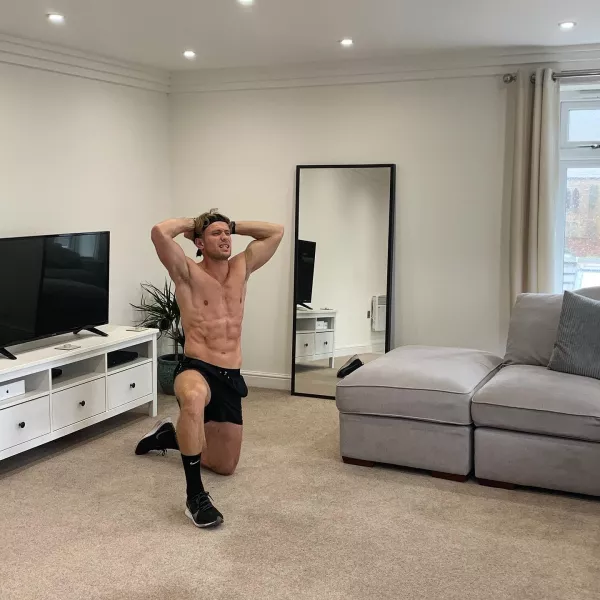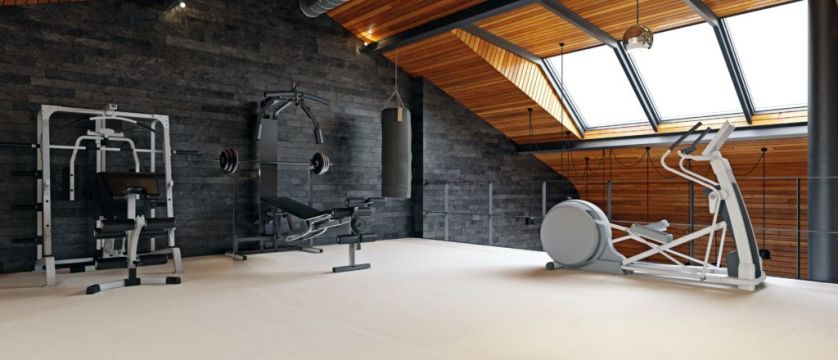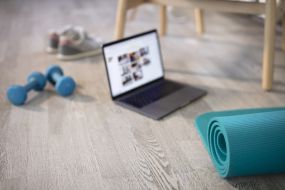Home gyms were once the preserve of the wealthy, but since the closure of gyms and leisure centres during the coronavirus pandemic, the popularity of home exercise and the resulting desire for home workout spaces, has really gathered pace.
Many people, of course, cannot afford to create a bespoke gym in their home and simply use an exercise mat – or a rug – in a corner.
The home exercise space you use can be as small and simple or as large and luxurious as you like or can afford – but ultimately, all you really need is a couple of metres of space and a big dollop of motivation to be able to exercise at home.
Personal trainer Henry Myers, who runs HM Fitness (facebook.com/HMFpersonaltraining) in the UK, and regularly leads Zoom classes for people working out at home, stresses that even if you’ve only got a small space available in your house or garden, there’s nothing you can’t do.
“You can do a good workout in a couple of square metres, and you don’t have to spend any money to benefit from the flexibility of working out at home,” he says.

“But if you’ve got the space, and some extra money, having a dedicated exercise area or room can be really motivational. It’s similar to having an office at home instead of having to work with your laptop on your knee – you’ve got everything you need to hand, and it can help you to focus on what you’re doing. Plus, there’s the added incentive that if you’ve spent a lot setting up your own home gym, you’re more likely to use it to make sure you’re getting value for money.”
Mark Reynolds, founder of WeMakeGyms (wemakegyms.com), says since the pandemic struck, the home gym market has boomed, and it’s not just the wealthy who are creating their own home workout spaces.
“Until the last few years, the home gym was perceived to be something only the rich and famous could afford, but that’s all very much changed since Covid-19 reared its ugly head,” he says.
“A home gym can be as elaborate or simple as you like, from jumping up and down in your bedroom in front of your favourite Instagram personal trainer, cornering off a section of your living room with some cardio equipment and weights, to a fully-functioning separate room that’s air-conditioned and adorned with the latest fitness technology.”
View this post on InstagramAdvertisement
Reynolds says people thinking of creating a home gym should remember what they’ll be saving on family gym memberships or fitness classes over subsequent years. “It can all quickly add up,” he points out, “so the appeal of an at-home gym becomes ever more prevalent.”
Your own exercise space can cost what you want or can afford – from a few pounds for a gym mat, around £2,500 for a basic custom-designed set-up with a cardio machine, a few weights, a bench and new flooring, or a £30,000 converted room or garage with all mod cons, says Reynolds.
“At home, you determine when you work out, and that can take place at any time of the day or night. A new normal is being created, and what people are starting to see is the pure flexibility and long-term cost-effectiveness of an at-home gym.”
1. Use a room corner
“You don’t need a lot of room to lay down a yoga mat, which could be the foundation of your workout space, where you can stretch and do core exercises, Pilates or yoga,” says Reynolds.
Aside from mat exercises, more vigorous workouts like Hiit (high intensity interval training) may sometimes warrant a little more space, although most exercises can be done on the spot – even jogging. A solid floor to jump around on is useful, although not essential (your carpet, however, may not benefit from repeated jogging on the spot).
A skipping rope and resistance bands are great basic (and cheap) exercise tools if you don’t have the space or cash for an exercise machine. In addition, adjustable dumbbells, or a small set on a vertical rack, only require minimal storage.
2. Use a dedicated area
If you have the space to dedicate to a workout area within a larger room, a sliding door will take up less space than a swing door and keep the area separate from the rest of the room. You could also use a portable screen or even curtains to divide the space, Reynolds suggests.
To keep workout gear organised, hang some shelves or get a small storage unit. It can sometimes be a problem to store bulky weights, says Reynolds, but careful storage design can solve this issue.
If the space is permanent, you may want to change the flooring – consider temporary interlocking rubber mats, or something more durable and permanent, such as rubber flooring in tiles or rolls, which will provide physical and audible cushioning for your workout, and prevent slipperiness from sweat and/or fast movement.

Keep your form in check by making a mirror wall part of your design scheme – it can brighten up the space, and make it feel much larger, says Reynolds. Another option is to hang a punchbag from the ceiling – it can always be unhooked and removed to make more space. Alternatively, buy a floor-standing punchbag.
A basic custom-designed set-up including one cardio machine, dumbbells, an adjustable bench and flooring will cost around £2,500-£5,000, says Reynolds.
3. Create a fitness wall
Wall workouts are popular, especially for tight spaces, because they don’t require bulky equipment. Fitness walls combine tools for strength training, such as resistance bands, body straps, pull-up bars and even foldable squat racks with an integrated adjustable bench. A fitness wall can be as elaborate or simple as you like, explains Reynolds, and can incorporate hooks or bars to attach resistance bands or other suspension training apparatus to, as well as built-in equipment like cable and/or battle rope pulleys. A fitness wall can also support an angled sit-up bench, or beams that can provide support for total body stretches.
4. Convert a space
Garages, basements and attics can be ideal for converting into a permanent home gym, with the benefit of adding value to your property, says Reynolds.
If you’ve got a spacious garden or outbuilding, you could install a standalone gym, which you could combine with a home office space if necessary. Mirrors on the walls will open up and brighten the space, and a wall TV can help cardio time go much more quickly, or connect to an on-demand fitness service. A good sound system to play your favourite tracks as you workout is also useful as a motivational tool.
A custom-designed luxury home gym with two or three cardio machines, a squat rack, free weights, cable machine, adjustable bench, combat fitness equipment, a feature wall, custom flooring, audio, visual equipment and air conditioning will cost around £30,000, says Reynolds.







